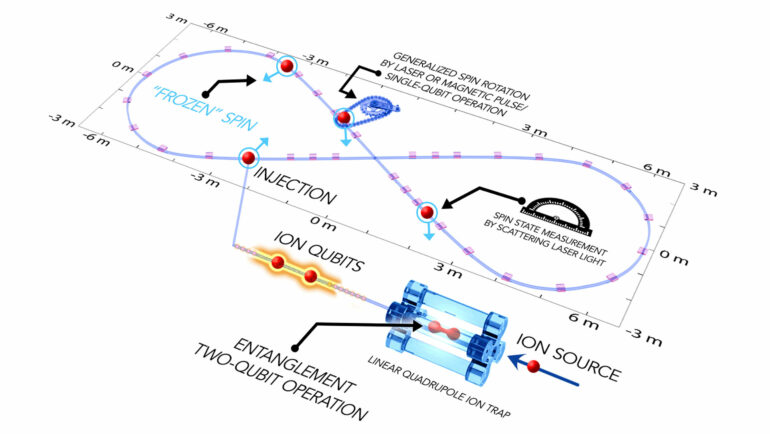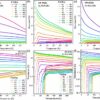Deep in outer space, invisible hands mold the universe. One is dark matter, an unseen substance thought to bind distant galaxies. The other is dark energy, a force believed to push stellar structures apart with gravity-defying strength.
Searching for signs of these strange cosmic influences, scientists at the U.S. Department of Energy’s Thomas Jefferson National Accelerator Facility designed a device to measure their supposed effects on spinning electrons. Then, they realized the idea held promise in another realm: quantum computing.
Quantum computers are the next frontier in information technology. Once confined to far-off theory and science fiction, these machines harness the wacky, wonderful forces of the submicroscopic world to solve problems that might be too tough for classical computers—think 1s and 0s—and even the massive, extreme-scale supercomputers of today.
The booming, global pursuit has made tremendous leaps in recent years, with large tech companies, startups and governments pursuing a mixed bag of platforms—each with strengths and weaknesses. But owing to the delicate mechanics on which these systems operate, the decades-long quest to bring them into reliable and practical use has so far proven elusive.
Now, a Jefferson Lab-led team is throwing its hat into the proverbial ring with a unique “CPU” born from particle accelerator technology and the study of the visible universe. It could rival or even outperform some of the noisy, energy-hungry prototypes being explored.
“We’re finding new avenues for our existing expertise in nuclear physics,” said Riad Suleiman, the lead investigator on the study. “Our goal is to open a new era of quantum computing research at Jefferson Lab.”
Familiar ring
Suleiman specializes in injectors, the devices that imbue particle accelerators with their beams. He began working at Jefferson Lab as a Kent State University student in 1995 and joined the staff full-time in 2007 after stints as a postdoctoral fellow with MIT and Virginia Tech. Suleiman has joined Vasiliy Morozov, a former Jefferson Lab accelerator physicist who works at the DOE’s Oak Ridge National Laboratory, and Matt Grau, a trapped-ion quantum computing expert from Old Dominion University.
A full patent was filed on their quantum computing “core,” which involves trapping charged atoms (ions) and injecting them into a figure-eight-shaped beamline. This stainless steel, vacuum-sealed ring is designed to maintain ions’ spin as they circulate. Stored in this way, the atoms can act as quantum bits—qubits, for short.
The project got its start in 2022 under Jefferson Lab’s Laboratory Directed Research and Development (LDRD) program, but its history goes way back.
Morozov spent more than a decade at Jefferson Lab before joining Oak Ridge in 2020. He was involved in early design concepts for the Electron-Ion Collider (EIC), a next-generation particle accelerator being built at the DOE’s Brookhaven National Laboratory in partnership with Jefferson Lab.
One of the EIC designs involved beamlines shaped like a figure eight, including a ring for storing electrons before they smack against accelerated ions.
“The challenge in some accelerators is having the spin of all particles pointing in the same direction,” said Morozov, who is still involved with the EIC. “You have to keep them aligned because, if you’re not careful, you end up with a completely chaotic orientation. The figure eight was proposed as a universal way to maintain this alignment for precision experiments.”
The DOE’s ultimate EIC selection was a mostly circular design, but the figure-eight model wasn’t scrapped. Suleiman and Morozov formed a team to explore another use for these novel rings: the search for clues about the origin and structure of the universe.
The physical world owes its existence to an excess of matter over antimatter, and Suleiman said figure-eight rings are an ideal place to measure electron properties that could explain this imbalance. Spinning within these rings, the elementary particles are also expected to be hypersensitive to hypothetical forces related to dark matter and dark energy.
During this research, Suleiman’s team conjured another use for the rings.
“That’s how the idea came to life,” Suleiman said.
Quantum realm
Quantum computers don’t necessarily make for a faster or smaller CPU, so you won’t find one on your desk—or lap—anytime soon. They just have access to a different computational space.
“For some of the hardest problems that supercomputers are tackling today, there is the potential for quantum computers to solve them extremely efficiently,” Grau said.
Fields that could benefit include cryptography, data science, search algorithms and artificial intelligence. Another is the modeling of quantum systems, such as nanomaterials, quantum chemistry, quantum optics and quantum field theories.
“It turns out that these computers are very good at solving quantum physics problems,” Grau said. “This is really useful if you want to simulate the pathways for certain chemical reactions or how an interesting protein in a drug might work. Rather than trying it in a beaker, you can try it in a computer that naturally speaks the language of quantum mechanics.”
Qubits can be likened to the binary bits of a classical computer. But instead of representing only a 1 or 0, they can represent many different computable states simultaneously through the weird quantum property of superposition. Their processing power can be further amplified by stringing them together via another quirky quantum feature called entanglement.
Entanglement is a fundamental strangeness of quantum systems in which particles’ physical states, such as spin, can be directly correlated—in principle even if they are light-years apart. This can be accomplished within a trap that confines the ions—in this case, Ytterbium—using an oscillating electric field. The trap is under ultrahigh vacuum and cooled to temperatures colder than deep space.
“A millionth of a degree above absolute zero is where all the motion has basically been frozen out, and these particles are completely still,” Grau said. “At these very cold temperatures, you can get an extreme amount of control. This is critical to operating quantum computers.”
From there, a combination of static and time-varying electric fields injects the ions into the ring.
Rating eights
Big tech firms such as Amazon, Google, Microsoft and IBM are exploring superconducting-based quantum computing, and another Jefferson Lab team is partnering with the private sector to explore ultra-energy-efficient superconducting digital electronics. Other companies and startups are looking into neutral atoms, trapped ions and photonics, but it’s unclear which technology will separate from the pack.
Arguably, the most critical requirement of a quantum computer is that it be a “closed box,” meaning it must be isolated from the rest of the universe. External interference or information leakage from within can disturb the foamy sea of probabilities on which the computer operates.
Isolation through prevention and cancellation of external interactions allows the ions to maintain their quantum states. This quality is called coherence, and it must last long enough for the computer to perform its complex algorithms.
Thanks to a beamline vacuum and naturally occurring cancellation of the spin effects in a figure-eight layout, such a ring is expected to offer coherence times of greater than three hours. Like in the Marvel Cinematic Universe’s “Ant-Man” franchise, three hours is a lifetime in the quantum world—and this lifetime far surpasses the current state of the art.
For comparison, IBM’s superconducting Condor computer offers coherence times of about 200 microseconds, and Xanadu’s 216-qubit system can go about 34 milliseconds without decohering. Quantinuum’s H2 trapped-ion system performs a little better than these platforms with coherence greater than 100 seconds, and Atom Computing’s neutral-atom platform has a 40-second span.
The figure-eight ring is also expected to outperform these systems in the number of qubits it can store. At about 12 meters long and 6 meters wide—about the area of a small apartment—these rings could amass as many as 3,000 qubits. They can scale up even further by stacking multiple rings, Suleiman said. The sheer number of qubits would go a long way in fault tolerance and error correction.
“Being able to compute accurately with error correction usually means that you need way more qubits than you would to satisfy the needs of your algorithm,” Grau said. “So, scaling is really, in the end, the big challenge that all quantum computers have to face.”
Meanwhile, IBM’s Condor operates on 1,121 qubits and Atom Computing’s neutral-atom machine has 1,180. Quantinuum’s H2 currently uses 32 qubits, as does IonQ’s Forte trapped-ion system.
Brookhaven Lab is also examining storage rings for quantum computing, but its patented model is elliptical in design and relies on extreme beam cooling. Meanwhile, Suleiman’s team is on the verge of a full patent for its figure-eight that takes advantage of rather robust quantum spin effects not involving hard-to-achieve quantum features of the particle’s orbital motion.
“The figure-eight storage ring was developed simply to preserve particles’ spins,” Suleiman said. “It’s a very simple concept but turned out to be fruitful when you apply it to different areas. If we can start demonstrating its capabilities, we can one day work with a company to further develop the idea.”
Provided by
Thomas Jefferson National Accelerator Facility
Citation:
Spooky states and figure eights: Stepping into the quantum computing ‘ring’ (2024, May 15)



